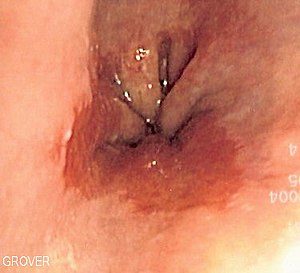Minimally invasive, cost-effective alternative to endoscopy identifies precursor to cancer of the esophagus (Barrett’s esophagus)
Do you have symptoms of Barrett’s Esophagus or Gastroesophageal Reflux Disease (GERD)? Are you worried about esophageal cancer (EC)? More than anything you want two of the things mentioned in the subhead above- 1) minimally invasive and 2) cost-effective. I say this because a person who has been living with heartburn or who is worried about GERD, BE or EC needs to know that the diagnostic tests are taken to determine if he has any of the conditions mentioned are easy.

The reason I say this is for two reasons. First, it is important for patients, whatever the stage, to accurately figure out where they are. Secondly, the study linked below says that if BE is diagnosed, “The diagnosis of Barrett’s esophagus does not lead to specific therapy.”
My experience proves otherwise. I think that any pre-cancerous condition can be addressed through evidence-based, non-toxic therapies such as diet, supplements, and lifestyle.
I have been living with incurable cancer since early 1999. I believe that evidence-based therapies such as nutrition, supplementation, and lifestyle are the reason for my long-term complete remission.
Do you think you have GERD, BE or EC? Scroll down the page, post a question or comment and I will reply to you ASAP.
Thank you,
David Emerson
- Cancer Survivor
- Cancer Coach
- Director PeopleBeatingCancer
Recommended Reading:
“Investigators at Case Western Reserve University School of Medicine and University Hospitals Cleveland Medical Center have developed a simple, swallowable test for early detection of Barrett’s esophagus that offers promise for preventing deaths from esophageal adenocarcinoma…
“Our goal is early detection,” said Dr. Chak. “Symptoms of Barrett’s esophagus, such as heartburn, can also be commonly seen in individuals who have acid reflux disease without BE. These symptoms can easily be treated by over the counter medications so people often don’t get tested for BE, particularly by an invasive test such as endoscopy. As a result, when individuals develop EAC, 95 percent of the time the presence of the prior Barrett’s esophagus was undetected and unknown…”
“Barrett’s esophagus is a serious complication of GERD, which stands for gastroesophageal reflux disease. In Barrett’s esophagus, the normal tissue lining the esophagus — the tube that carries food from the mouth to the stomach — changes to tissue that resembles the lining of the intestine. About 10% of people with chronic symptoms of GERD develop Barrett’s esophagus.
Barrett’s esophagus does not have any specific symptoms, although patients with Barrett’s esophagus may have symptoms related to GERD. It does, though, increase the risk of developing esophageal adenocarcinoma, which is a serious, potentially fatal cancer of the esophagus.
Although the risk of this cancer is higher in people with Barrett’s esophagus, the disease is still rare. Less than 1% of people with Barrett’s esophagus develop this particular cancer. Nevertheless, if you’ve been diagnosed with Barrett’s esophagus, it’s important to have routine examinations of your esophagus. With routine examination, your doctor can discover precancerous and cancer cells early, before they spread and when the disease is easier to treat…”
“Approach Considerations- The diagnosis of Barrett’s esophagus does not lead to specific therapy. Little evidence supports the assumption that antisecretory agents or antireflux surgery prevents the occurrence of adenocarcinoma or leads to regression of Barrett’s esophagus. [13]
In the early to mid-1980s, histamine 2 (H2)-receptor antagonists were the most commonly prescribed agents for the treatment of GERD. However, a number of studies were conducted with either cimetidine or ranitidine, and none documented regression of BE.
In the late 1980s, proton pump inhibitors (PPIs) were introduced and proved to be much more efficacious in reducing gastric acid secretion. Even so, the supposition that better acid suppression could induce BE regression was met with optimism, and studies on this to date have been inconclusive. Only 2 of 7 investigators demonstrated some regression. Most were unable to detect any regression, despite documentation of complete normalization of esophageal pH by pH testing.
Currently, the indications for medical therapy in BE—control of symptoms and healing of esophageal mucosa—are the same as those for GERD. An important, as yet unanswered, the question is whether abolishing acid completely with high-dose PPIs decreases the risk for adenocarcinoma of the esophagus and warrants the cost and possible adverse effects of this therapy…
The Most BioAvailable Curcumin Formulas
“Based on a review of these studies, it is evident that better bioavailability of formulated curcumin (CU) products is mostly attributed to improved solubility, stability, and possibly low first-pass metabolism”
A search of the Pubmed database for the word curcumin yields 601 studies spaning health topics from multiple myeloma and colorectal cancer, to chemotherapies that synergizes with CU, to Alzheimer’s Disease, arthritis and more. Based on years of reading studies and personal accounts, I think it is safe to say that CU supplementation is safe and relatively inexpensive.

I have read about myeloma patients taking daily doses of CU from 400 milligrams to 8 grams (1000 milligrams = 1 gram). By almost any measure, CU is a safe, inexpensive wonder drug.
The only challenge is that CU is famously difficult to absorb in the body. In other words, a person has to mix curcumin with some sort of fat (coconut oil, chocolate, etc.) or take a brand of curcumin capsule that is already formulated to be more “bioavailable” in order to derive the full benefit of CU.
The study linked and exerpted below reviews different formulations of CU. The study itself lists the three most bioavailable formulation/brand of CU and I’ve added an excerpt from a further review from Consumerlab.com that lists four additional bioavailable brands of CU.
I consult the independent evaluation service Consumerlab.com frequently. For one low annual payment, I can read about and evaluate all of the nutritional supplement that I take.
Recommended Reading:
“CU is a bright yellow chemical produced by some plants. It is the principal curcuminoid of turmeric (Curcuma longa), a member of the ginger family, Zingiberaceae. It is sold as an herbal supplement, cosmetics ingredient, food flavoring, and food coloring.[1]“
“Curcumin is a widely studied natural compound which has shown tremendous in vitro therapeutic potential. Despite that, the clinical efficacy of the native CU is weak due to its low bioavailability and high metabolism in the gastrointestinal tract. During the last decade, researchers have come up with different formulations with a focus on improving the bioavailability of curcumin. As a result, a significant number of bioavailable curcumin-based formulations were introduced with the varying range of enhanced bioavailability.
The purpose of this review is to collate the published clinical studies of CU products with improved bioavailability over conventional (unformulated) CU. Based on the literature search, 11 curcumin formulations with available human bioavailability and pharmacokinetics data were included in this review. Further, the data on clinical study design, analytical method, pharmacokinetic parameters and other relevant details of each formulation were extracted.
Based on a review of these studies, it is evident that better bioavailability of formulated curcumin products is mostly attributed to improved solubility, stability, and possibly low first-pass metabolism. The review hopes to provide a quick reference guide for anyone looking information on these bioavailable curcumin formulations.
Based on the published reports,
exhibited over 100-fold higher bioavailability relative to reference unformulated CU. Suggested mechanisms accounting for improved bioavailability of the formulations and details on the bioanalysis methods are also discussed.”
According to Consumerlab.com:
“Novasol has the highest bioavailability (185 x compared to unforumulated CU), followed by Curcuwin (136 x), Longvida (100 x), Meriva (48 x), BCM-95 (27 x), Curcumin C3 Complex + Bioperene (20 x), and then Theracumin (16 x).”
APPIP ERROR: amazonproducts[
AccessDeniedAwsUsers|The Access Key Id AKIAJAJ37JVNL7OUU4CA is not enabled for accessing this version of Product Advertising API. Please migrate your credentials as referred here https://webservices.amazon.com/paapi5/documentation/migrating-your-product-advertising-api-account-from-your-aws-account.html.
]





